Nursing Reflection: Post-Angioplasty Care and Clinical Handover
VerifiedAdded on 2023/01/19
|7
|1952
|65
Report
AI Summary
This nursing reflection analyzes the care of a post-angioplasty patient named Bright, focusing on the strengths and weaknesses of the assessment process and the clinical handover procedure. The assessment section highlights the successful monitoring of vital signs, adherence to the PQRST method for pain assessment, and the adoption of a multidisciplinary approach. However, it also identifies failures in providing pain relief, checking the patient's ABCD, monitoring BGL and chest, and contacting the physician before leaving the facility. The clinical handover section emphasizes the importance of transferring patient information, adhering to the National Safety and Quality Health Service Standards, and utilizing the ISBAR format for effective communication. The report underscores the importance of accurate documentation and the need for clear recommendations to ensure safe and quality patient care. The reflection references relevant research and emphasizes the importance of teamwork and adherence to nursing standards.
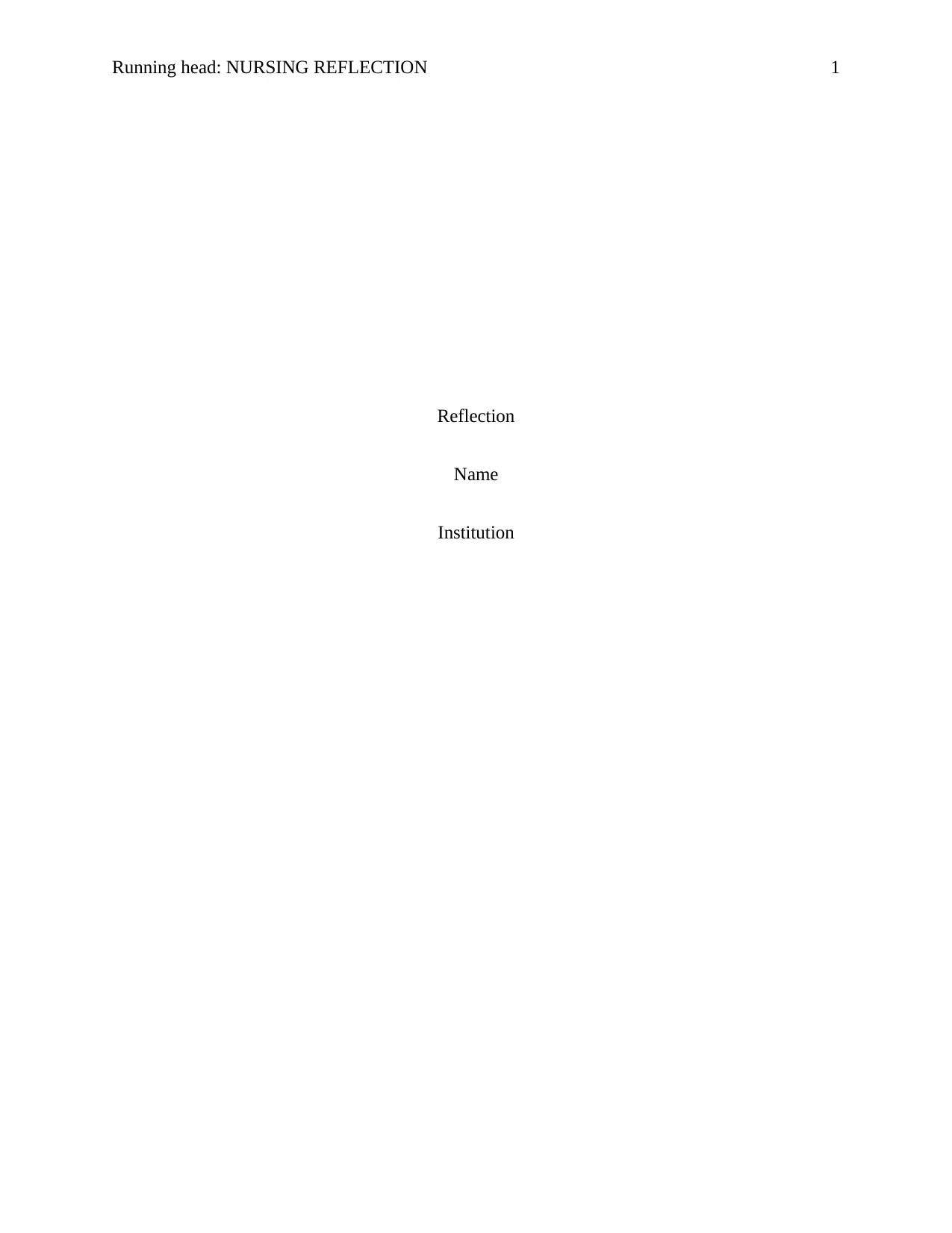
Running head: NURSING REFLECTION 1
Reflection
Name
Institution
Reflection
Name
Institution
Paraphrase This Document
Need a fresh take? Get an instant paraphrase of this document with our AI Paraphraser
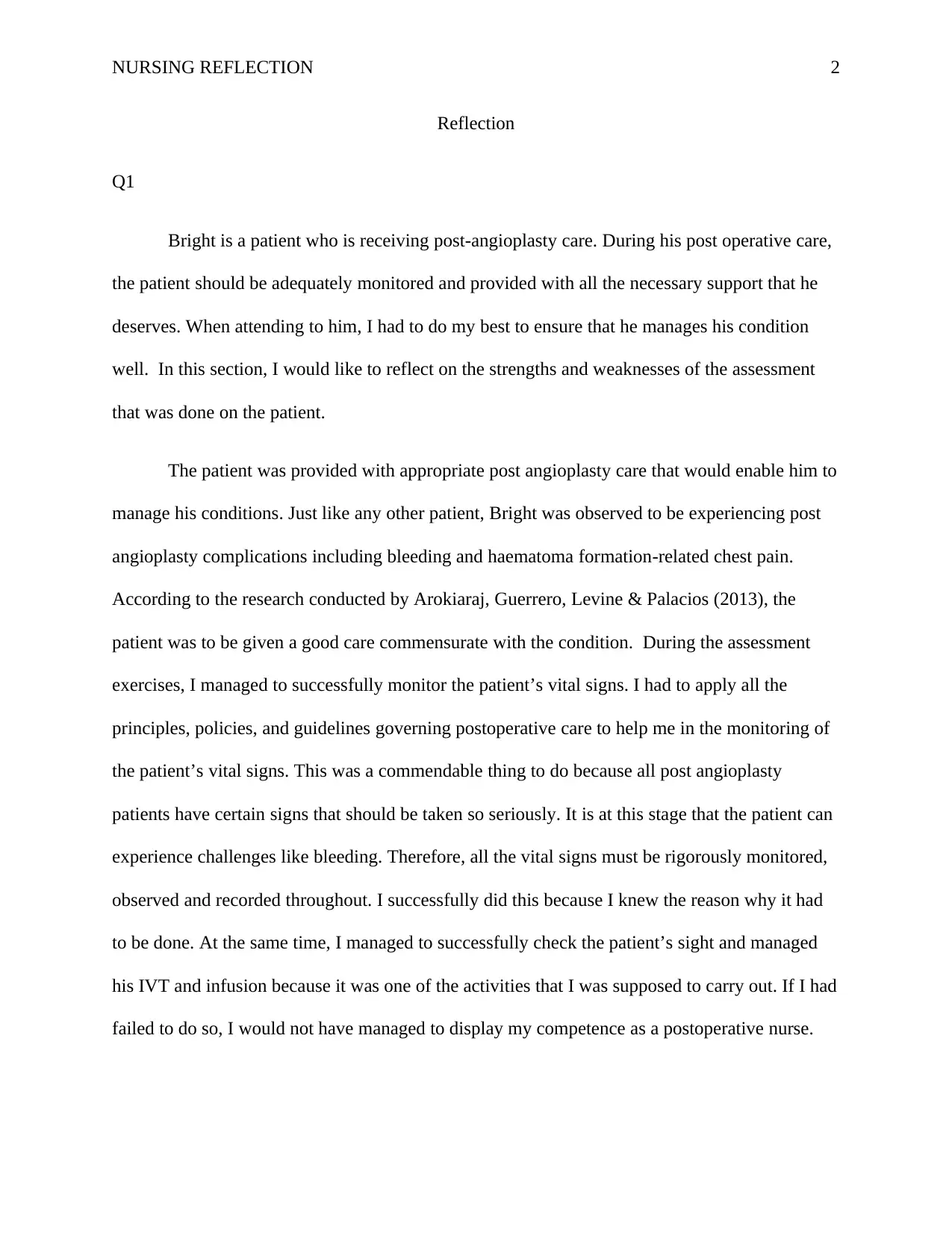
NURSING REFLECTION 2
Reflection
Q1
Bright is a patient who is receiving post-angioplasty care. During his post operative care,
the patient should be adequately monitored and provided with all the necessary support that he
deserves. When attending to him, I had to do my best to ensure that he manages his condition
well. In this section, I would like to reflect on the strengths and weaknesses of the assessment
that was done on the patient.
The patient was provided with appropriate post angioplasty care that would enable him to
manage his conditions. Just like any other patient, Bright was observed to be experiencing post
angioplasty complications including bleeding and haematoma formation-related chest pain.
According to the research conducted by Arokiaraj, Guerrero, Levine & Palacios (2013), the
patient was to be given a good care commensurate with the condition. During the assessment
exercises, I managed to successfully monitor the patient’s vital signs. I had to apply all the
principles, policies, and guidelines governing postoperative care to help me in the monitoring of
the patient’s vital signs. This was a commendable thing to do because all post angioplasty
patients have certain signs that should be taken so seriously. It is at this stage that the patient can
experience challenges like bleeding. Therefore, all the vital signs must be rigorously monitored,
observed and recorded throughout. I successfully did this because I knew the reason why it had
to be done. At the same time, I managed to successfully check the patient’s sight and managed
his IVT and infusion because it was one of the activities that I was supposed to carry out. If I had
failed to do so, I would not have managed to display my competence as a postoperative nurse.
Reflection
Q1
Bright is a patient who is receiving post-angioplasty care. During his post operative care,
the patient should be adequately monitored and provided with all the necessary support that he
deserves. When attending to him, I had to do my best to ensure that he manages his condition
well. In this section, I would like to reflect on the strengths and weaknesses of the assessment
that was done on the patient.
The patient was provided with appropriate post angioplasty care that would enable him to
manage his conditions. Just like any other patient, Bright was observed to be experiencing post
angioplasty complications including bleeding and haematoma formation-related chest pain.
According to the research conducted by Arokiaraj, Guerrero, Levine & Palacios (2013), the
patient was to be given a good care commensurate with the condition. During the assessment
exercises, I managed to successfully monitor the patient’s vital signs. I had to apply all the
principles, policies, and guidelines governing postoperative care to help me in the monitoring of
the patient’s vital signs. This was a commendable thing to do because all post angioplasty
patients have certain signs that should be taken so seriously. It is at this stage that the patient can
experience challenges like bleeding. Therefore, all the vital signs must be rigorously monitored,
observed and recorded throughout. I successfully did this because I knew the reason why it had
to be done. At the same time, I managed to successfully check the patient’s sight and managed
his IVT and infusion because it was one of the activities that I was supposed to carry out. If I had
failed to do so, I would not have managed to display my competence as a postoperative nurse.
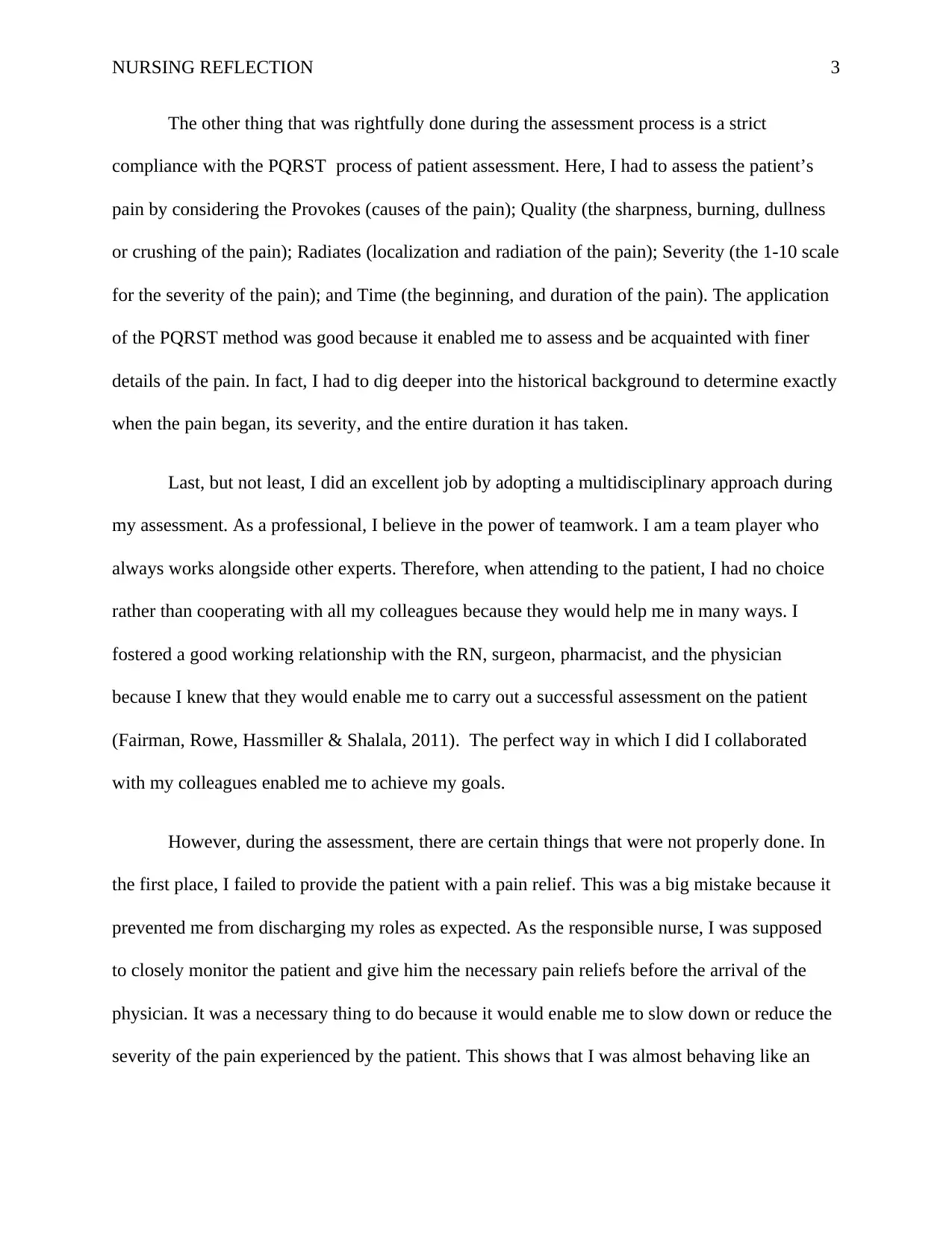
NURSING REFLECTION 3
The other thing that was rightfully done during the assessment process is a strict
compliance with the PQRST process of patient assessment. Here, I had to assess the patient’s
pain by considering the Provokes (causes of the pain); Quality (the sharpness, burning, dullness
or crushing of the pain); Radiates (localization and radiation of the pain); Severity (the 1-10 scale
for the severity of the pain); and Time (the beginning, and duration of the pain). The application
of the PQRST method was good because it enabled me to assess and be acquainted with finer
details of the pain. In fact, I had to dig deeper into the historical background to determine exactly
when the pain began, its severity, and the entire duration it has taken.
Last, but not least, I did an excellent job by adopting a multidisciplinary approach during
my assessment. As a professional, I believe in the power of teamwork. I am a team player who
always works alongside other experts. Therefore, when attending to the patient, I had no choice
rather than cooperating with all my colleagues because they would help me in many ways. I
fostered a good working relationship with the RN, surgeon, pharmacist, and the physician
because I knew that they would enable me to carry out a successful assessment on the patient
(Fairman, Rowe, Hassmiller & Shalala, 2011). The perfect way in which I did I collaborated
with my colleagues enabled me to achieve my goals.
However, during the assessment, there are certain things that were not properly done. In
the first place, I failed to provide the patient with a pain relief. This was a big mistake because it
prevented me from discharging my roles as expected. As the responsible nurse, I was supposed
to closely monitor the patient and give him the necessary pain reliefs before the arrival of the
physician. It was a necessary thing to do because it would enable me to slow down or reduce the
severity of the pain experienced by the patient. This shows that I was almost behaving like an
The other thing that was rightfully done during the assessment process is a strict
compliance with the PQRST process of patient assessment. Here, I had to assess the patient’s
pain by considering the Provokes (causes of the pain); Quality (the sharpness, burning, dullness
or crushing of the pain); Radiates (localization and radiation of the pain); Severity (the 1-10 scale
for the severity of the pain); and Time (the beginning, and duration of the pain). The application
of the PQRST method was good because it enabled me to assess and be acquainted with finer
details of the pain. In fact, I had to dig deeper into the historical background to determine exactly
when the pain began, its severity, and the entire duration it has taken.
Last, but not least, I did an excellent job by adopting a multidisciplinary approach during
my assessment. As a professional, I believe in the power of teamwork. I am a team player who
always works alongside other experts. Therefore, when attending to the patient, I had no choice
rather than cooperating with all my colleagues because they would help me in many ways. I
fostered a good working relationship with the RN, surgeon, pharmacist, and the physician
because I knew that they would enable me to carry out a successful assessment on the patient
(Fairman, Rowe, Hassmiller & Shalala, 2011). The perfect way in which I did I collaborated
with my colleagues enabled me to achieve my goals.
However, during the assessment, there are certain things that were not properly done. In
the first place, I failed to provide the patient with a pain relief. This was a big mistake because it
prevented me from discharging my roles as expected. As the responsible nurse, I was supposed
to closely monitor the patient and give him the necessary pain reliefs before the arrival of the
physician. It was a necessary thing to do because it would enable me to slow down or reduce the
severity of the pain experienced by the patient. This shows that I was almost behaving like an
⊘ This is a preview!⊘
Do you want full access?
Subscribe today to unlock all pages.

Trusted by 1+ million students worldwide
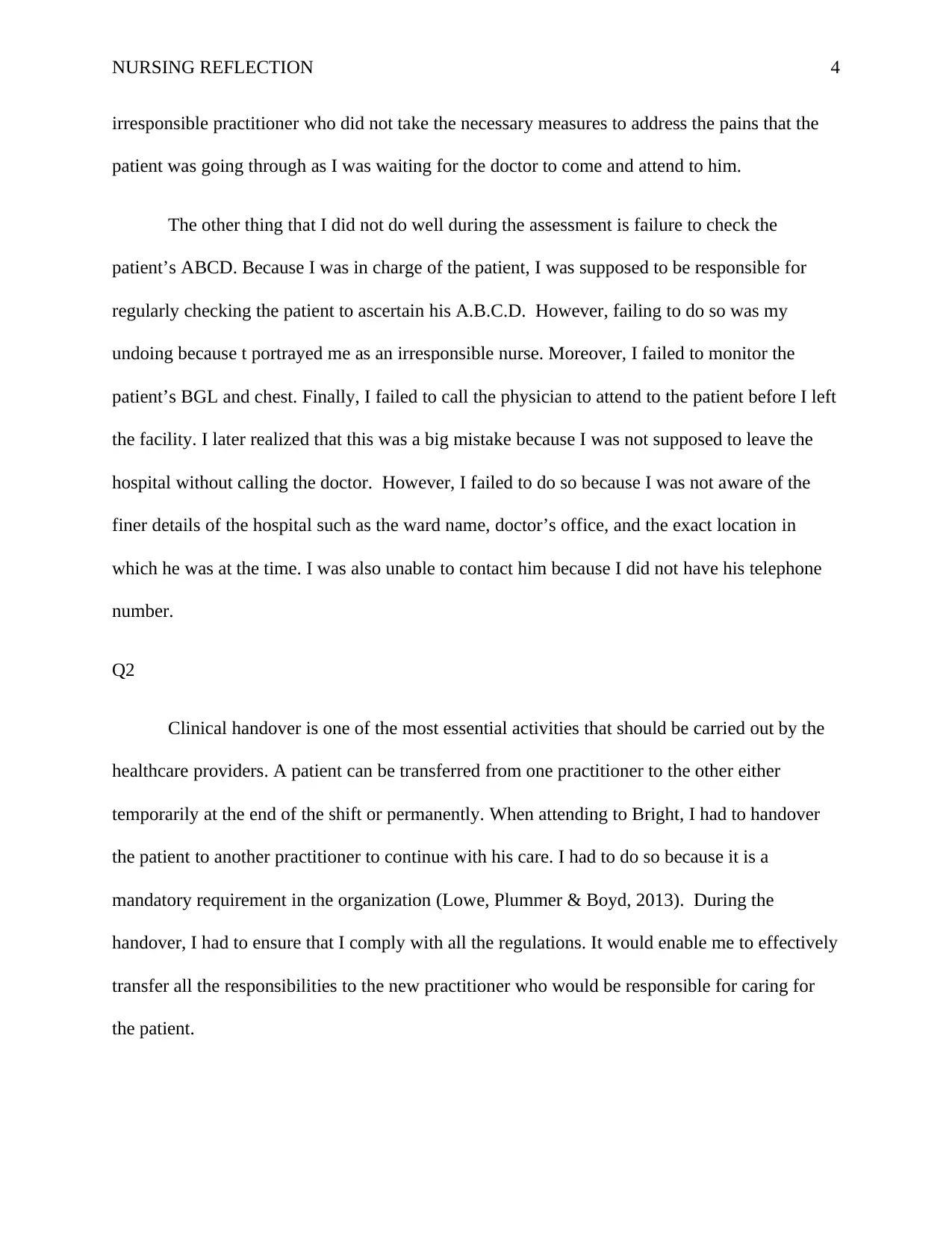
NURSING REFLECTION 4
irresponsible practitioner who did not take the necessary measures to address the pains that the
patient was going through as I was waiting for the doctor to come and attend to him.
The other thing that I did not do well during the assessment is failure to check the
patient’s ABCD. Because I was in charge of the patient, I was supposed to be responsible for
regularly checking the patient to ascertain his A.B.C.D. However, failing to do so was my
undoing because t portrayed me as an irresponsible nurse. Moreover, I failed to monitor the
patient’s BGL and chest. Finally, I failed to call the physician to attend to the patient before I left
the facility. I later realized that this was a big mistake because I was not supposed to leave the
hospital without calling the doctor. However, I failed to do so because I was not aware of the
finer details of the hospital such as the ward name, doctor’s office, and the exact location in
which he was at the time. I was also unable to contact him because I did not have his telephone
number.
Q2
Clinical handover is one of the most essential activities that should be carried out by the
healthcare providers. A patient can be transferred from one practitioner to the other either
temporarily at the end of the shift or permanently. When attending to Bright, I had to handover
the patient to another practitioner to continue with his care. I had to do so because it is a
mandatory requirement in the organization (Lowe, Plummer & Boyd, 2013). During the
handover, I had to ensure that I comply with all the regulations. It would enable me to effectively
transfer all the responsibilities to the new practitioner who would be responsible for caring for
the patient.
irresponsible practitioner who did not take the necessary measures to address the pains that the
patient was going through as I was waiting for the doctor to come and attend to him.
The other thing that I did not do well during the assessment is failure to check the
patient’s ABCD. Because I was in charge of the patient, I was supposed to be responsible for
regularly checking the patient to ascertain his A.B.C.D. However, failing to do so was my
undoing because t portrayed me as an irresponsible nurse. Moreover, I failed to monitor the
patient’s BGL and chest. Finally, I failed to call the physician to attend to the patient before I left
the facility. I later realized that this was a big mistake because I was not supposed to leave the
hospital without calling the doctor. However, I failed to do so because I was not aware of the
finer details of the hospital such as the ward name, doctor’s office, and the exact location in
which he was at the time. I was also unable to contact him because I did not have his telephone
number.
Q2
Clinical handover is one of the most essential activities that should be carried out by the
healthcare providers. A patient can be transferred from one practitioner to the other either
temporarily at the end of the shift or permanently. When attending to Bright, I had to handover
the patient to another practitioner to continue with his care. I had to do so because it is a
mandatory requirement in the organization (Lowe, Plummer & Boyd, 2013). During the
handover, I had to ensure that I comply with all the regulations. It would enable me to effectively
transfer all the responsibilities to the new practitioner who would be responsible for caring for
the patient.
Paraphrase This Document
Need a fresh take? Get an instant paraphrase of this document with our AI Paraphraser
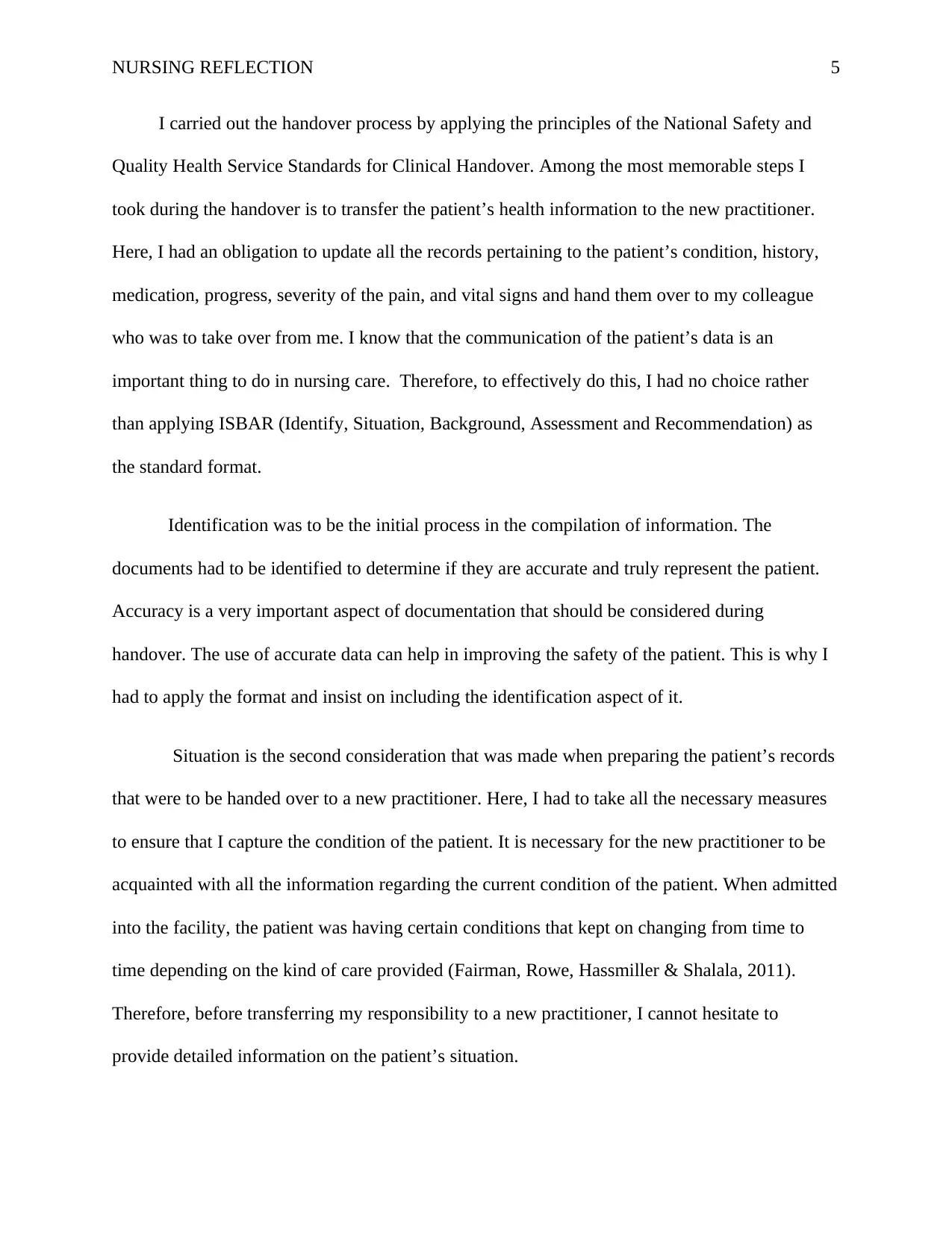
NURSING REFLECTION 5
I carried out the handover process by applying the principles of the National Safety and
Quality Health Service Standards for Clinical Handover. Among the most memorable steps I
took during the handover is to transfer the patient’s health information to the new practitioner.
Here, I had an obligation to update all the records pertaining to the patient’s condition, history,
medication, progress, severity of the pain, and vital signs and hand them over to my colleague
who was to take over from me. I know that the communication of the patient’s data is an
important thing to do in nursing care. Therefore, to effectively do this, I had no choice rather
than applying ISBAR (Identify, Situation, Background, Assessment and Recommendation) as
the standard format.
Identification was to be the initial process in the compilation of information. The
documents had to be identified to determine if they are accurate and truly represent the patient.
Accuracy is a very important aspect of documentation that should be considered during
handover. The use of accurate data can help in improving the safety of the patient. This is why I
had to apply the format and insist on including the identification aspect of it.
Situation is the second consideration that was made when preparing the patient’s records
that were to be handed over to a new practitioner. Here, I had to take all the necessary measures
to ensure that I capture the condition of the patient. It is necessary for the new practitioner to be
acquainted with all the information regarding the current condition of the patient. When admitted
into the facility, the patient was having certain conditions that kept on changing from time to
time depending on the kind of care provided (Fairman, Rowe, Hassmiller & Shalala, 2011).
Therefore, before transferring my responsibility to a new practitioner, I cannot hesitate to
provide detailed information on the patient’s situation.
I carried out the handover process by applying the principles of the National Safety and
Quality Health Service Standards for Clinical Handover. Among the most memorable steps I
took during the handover is to transfer the patient’s health information to the new practitioner.
Here, I had an obligation to update all the records pertaining to the patient’s condition, history,
medication, progress, severity of the pain, and vital signs and hand them over to my colleague
who was to take over from me. I know that the communication of the patient’s data is an
important thing to do in nursing care. Therefore, to effectively do this, I had no choice rather
than applying ISBAR (Identify, Situation, Background, Assessment and Recommendation) as
the standard format.
Identification was to be the initial process in the compilation of information. The
documents had to be identified to determine if they are accurate and truly represent the patient.
Accuracy is a very important aspect of documentation that should be considered during
handover. The use of accurate data can help in improving the safety of the patient. This is why I
had to apply the format and insist on including the identification aspect of it.
Situation is the second consideration that was made when preparing the patient’s records
that were to be handed over to a new practitioner. Here, I had to take all the necessary measures
to ensure that I capture the condition of the patient. It is necessary for the new practitioner to be
acquainted with all the information regarding the current condition of the patient. When admitted
into the facility, the patient was having certain conditions that kept on changing from time to
time depending on the kind of care provided (Fairman, Rowe, Hassmiller & Shalala, 2011).
Therefore, before transferring my responsibility to a new practitioner, I cannot hesitate to
provide detailed information on the patient’s situation.
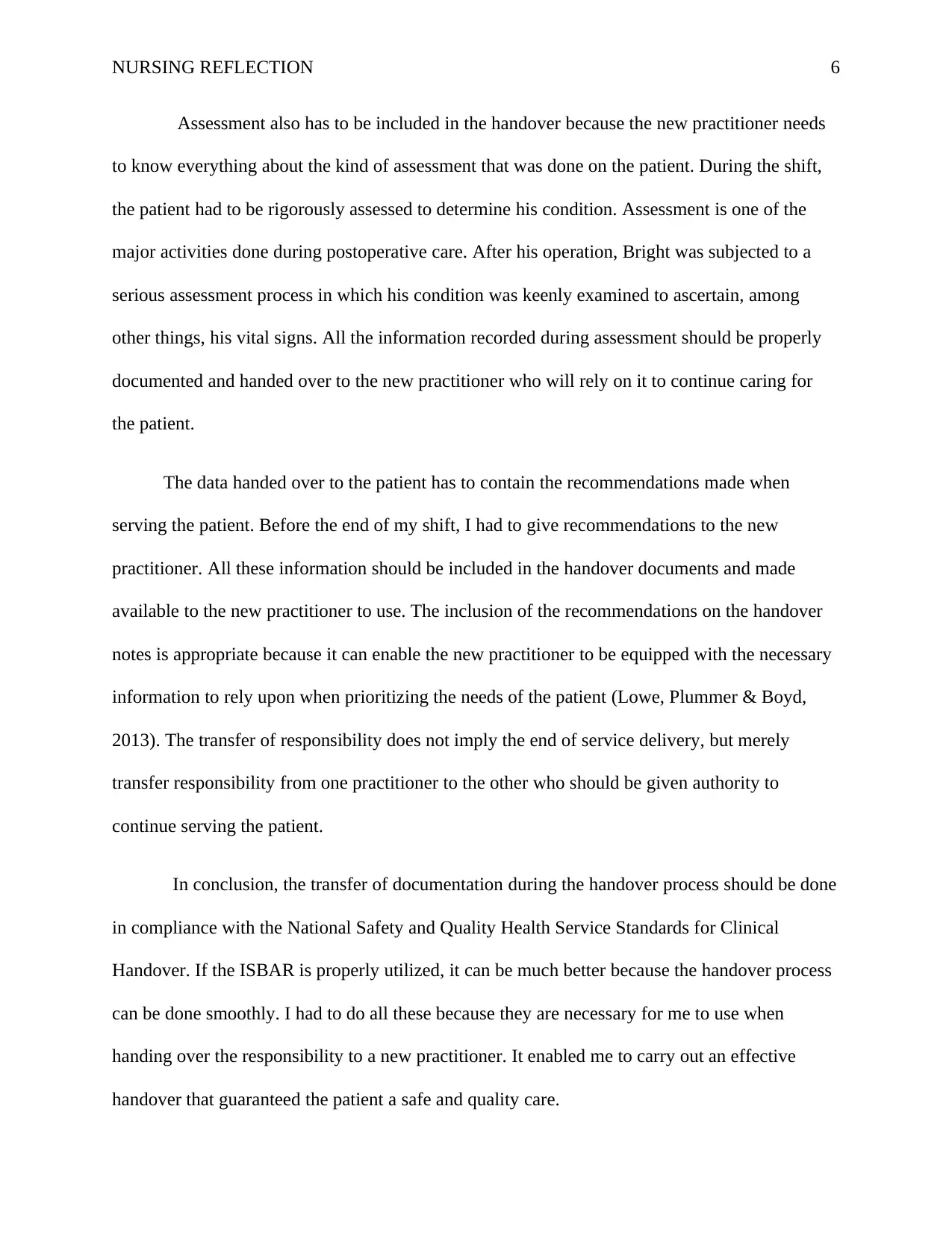
NURSING REFLECTION 6
Assessment also has to be included in the handover because the new practitioner needs
to know everything about the kind of assessment that was done on the patient. During the shift,
the patient had to be rigorously assessed to determine his condition. Assessment is one of the
major activities done during postoperative care. After his operation, Bright was subjected to a
serious assessment process in which his condition was keenly examined to ascertain, among
other things, his vital signs. All the information recorded during assessment should be properly
documented and handed over to the new practitioner who will rely on it to continue caring for
the patient.
The data handed over to the patient has to contain the recommendations made when
serving the patient. Before the end of my shift, I had to give recommendations to the new
practitioner. All these information should be included in the handover documents and made
available to the new practitioner to use. The inclusion of the recommendations on the handover
notes is appropriate because it can enable the new practitioner to be equipped with the necessary
information to rely upon when prioritizing the needs of the patient (Lowe, Plummer & Boyd,
2013). The transfer of responsibility does not imply the end of service delivery, but merely
transfer responsibility from one practitioner to the other who should be given authority to
continue serving the patient.
In conclusion, the transfer of documentation during the handover process should be done
in compliance with the National Safety and Quality Health Service Standards for Clinical
Handover. If the ISBAR is properly utilized, it can be much better because the handover process
can be done smoothly. I had to do all these because they are necessary for me to use when
handing over the responsibility to a new practitioner. It enabled me to carry out an effective
handover that guaranteed the patient a safe and quality care.
Assessment also has to be included in the handover because the new practitioner needs
to know everything about the kind of assessment that was done on the patient. During the shift,
the patient had to be rigorously assessed to determine his condition. Assessment is one of the
major activities done during postoperative care. After his operation, Bright was subjected to a
serious assessment process in which his condition was keenly examined to ascertain, among
other things, his vital signs. All the information recorded during assessment should be properly
documented and handed over to the new practitioner who will rely on it to continue caring for
the patient.
The data handed over to the patient has to contain the recommendations made when
serving the patient. Before the end of my shift, I had to give recommendations to the new
practitioner. All these information should be included in the handover documents and made
available to the new practitioner to use. The inclusion of the recommendations on the handover
notes is appropriate because it can enable the new practitioner to be equipped with the necessary
information to rely upon when prioritizing the needs of the patient (Lowe, Plummer & Boyd,
2013). The transfer of responsibility does not imply the end of service delivery, but merely
transfer responsibility from one practitioner to the other who should be given authority to
continue serving the patient.
In conclusion, the transfer of documentation during the handover process should be done
in compliance with the National Safety and Quality Health Service Standards for Clinical
Handover. If the ISBAR is properly utilized, it can be much better because the handover process
can be done smoothly. I had to do all these because they are necessary for me to use when
handing over the responsibility to a new practitioner. It enabled me to carry out an effective
handover that guaranteed the patient a safe and quality care.
⊘ This is a preview!⊘
Do you want full access?
Subscribe today to unlock all pages.

Trusted by 1+ million students worldwide
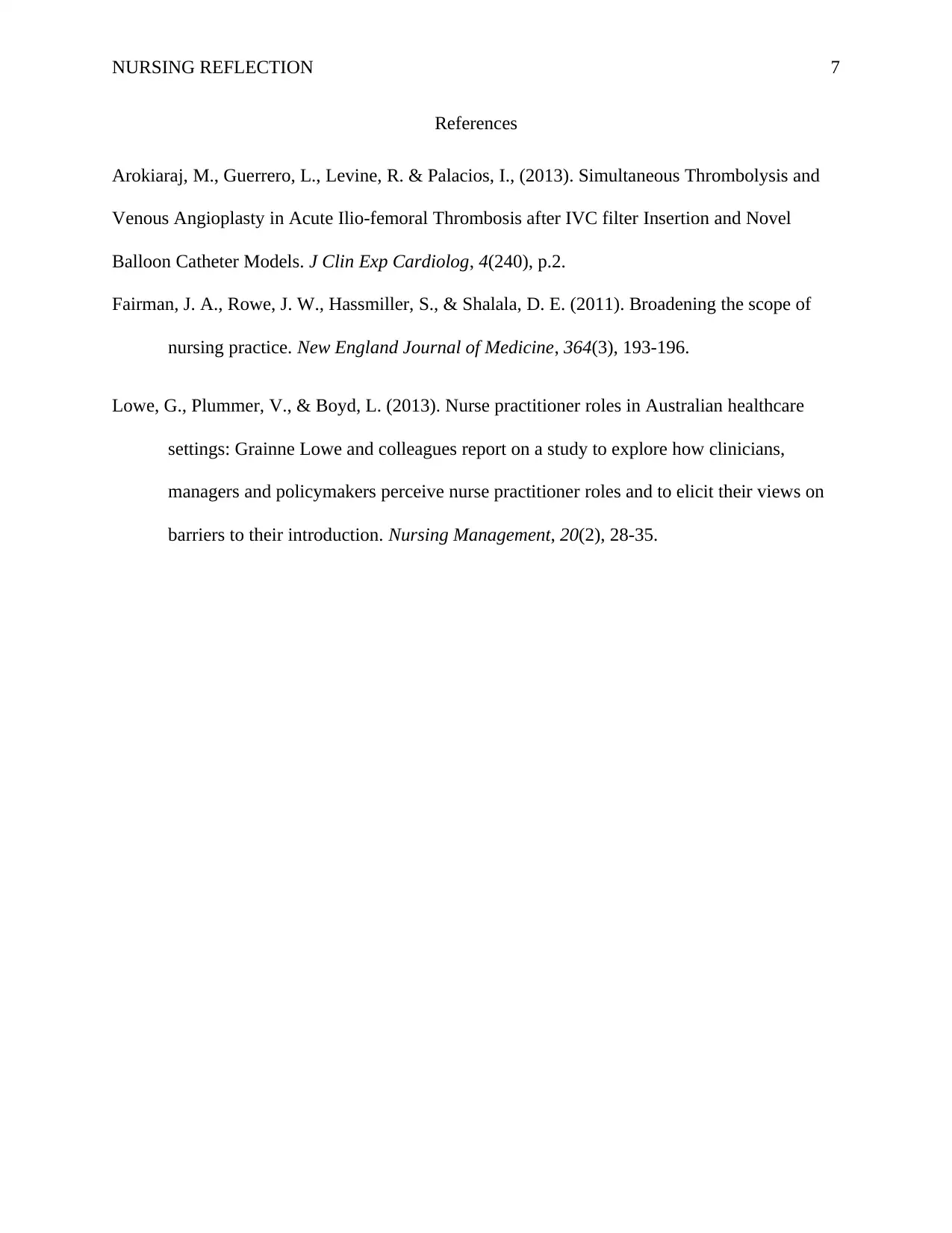
NURSING REFLECTION 7
References
Arokiaraj, M., Guerrero, L., Levine, R. & Palacios, I., (2013). Simultaneous Thrombolysis and
Venous Angioplasty in Acute Ilio-femoral Thrombosis after IVC filter Insertion and Novel
Balloon Catheter Models. J Clin Exp Cardiolog, 4(240), p.2.
Fairman, J. A., Rowe, J. W., Hassmiller, S., & Shalala, D. E. (2011). Broadening the scope of
nursing practice. New England Journal of Medicine, 364(3), 193-196.
Lowe, G., Plummer, V., & Boyd, L. (2013). Nurse practitioner roles in Australian healthcare
settings: Grainne Lowe and colleagues report on a study to explore how clinicians,
managers and policymakers perceive nurse practitioner roles and to elicit their views on
barriers to their introduction. Nursing Management, 20(2), 28-35.
References
Arokiaraj, M., Guerrero, L., Levine, R. & Palacios, I., (2013). Simultaneous Thrombolysis and
Venous Angioplasty in Acute Ilio-femoral Thrombosis after IVC filter Insertion and Novel
Balloon Catheter Models. J Clin Exp Cardiolog, 4(240), p.2.
Fairman, J. A., Rowe, J. W., Hassmiller, S., & Shalala, D. E. (2011). Broadening the scope of
nursing practice. New England Journal of Medicine, 364(3), 193-196.
Lowe, G., Plummer, V., & Boyd, L. (2013). Nurse practitioner roles in Australian healthcare
settings: Grainne Lowe and colleagues report on a study to explore how clinicians,
managers and policymakers perceive nurse practitioner roles and to elicit their views on
barriers to their introduction. Nursing Management, 20(2), 28-35.
1 out of 7
Related Documents
Your All-in-One AI-Powered Toolkit for Academic Success.
+13062052269
info@desklib.com
Available 24*7 on WhatsApp / Email
![[object Object]](/_next/static/media/star-bottom.7253800d.svg)
Unlock your academic potential
Copyright © 2020–2025 A2Z Services. All Rights Reserved. Developed and managed by ZUCOL.




